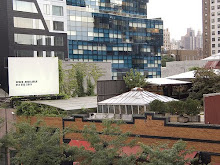


1) A view of Times Square in the 1920s (Thevillager.com). 2)
Times Square is one of the iconic sites of New York City, as it is home to the unforgettable theaters and upscale hotels. However, Times Square was not always the neon-flashing epicenter that it is known today – its sordid past lays in the underground yet mainstream culture of the commodification of sex, drugs, and prostitution. Urban renewal in this grandiose yet crucial space throughout the decades has been significant.
By the 1970s and 1980s,
Present: “Disneyland NYC”
The Forty-second Street Development Project, which included the Walt Disney Company, started an aggressive campaign to revamp the neighborhood’s image by getting rid of the city’s undesirables (gays, drug addicts, homeless).[4] Police were stationed everywhere to surveillance immoral, indecent and vagrant activities. Furthermore, an immediate crackdown of gay sexual outlets and drug users was initiated due to the AIDS epidemic of the 1980s.
Today, the results of the Forty-second Street Development Project are evident as the entire district has been transformed: gone are the sex shops and drug parlors, in are the fancy restaurants and family-friendly entertainment arenas. The “city-culture” appeal has seemingly turned Times Square into a theme park. Meanwhile, the few adult stores and 25cent peep shows that still linger have been relegated to outside of the Times Square area and are thus away from modernity and decency.
- Grayson Maldonado and Dalue (Roy) Song
[1] Delany, Samuel. Times Square Red, Times Square Blue. New York: NYU Press, 1999. xiv.
[2] Gilfoyle, Timothy J. City of Eros: New York City, Prostitution and the Commercialization of Sex. W.W. Norton & Co., 1994.
[3] Chauncey, George. Gay New York: Gender, Urban Culture, and the Making of the Gay Male World, 1890-1940. Basic Books, 1995.
[4] Gilfoyle, Timothy J. City of Eros: New York City, Prostitution and the Commercialization of Sex. W.W. Norton & Co., 1994.

Hostels cater a large group of guests in one room, it depend it's size and capacity.
ReplyDeleteCartagena in Colombia